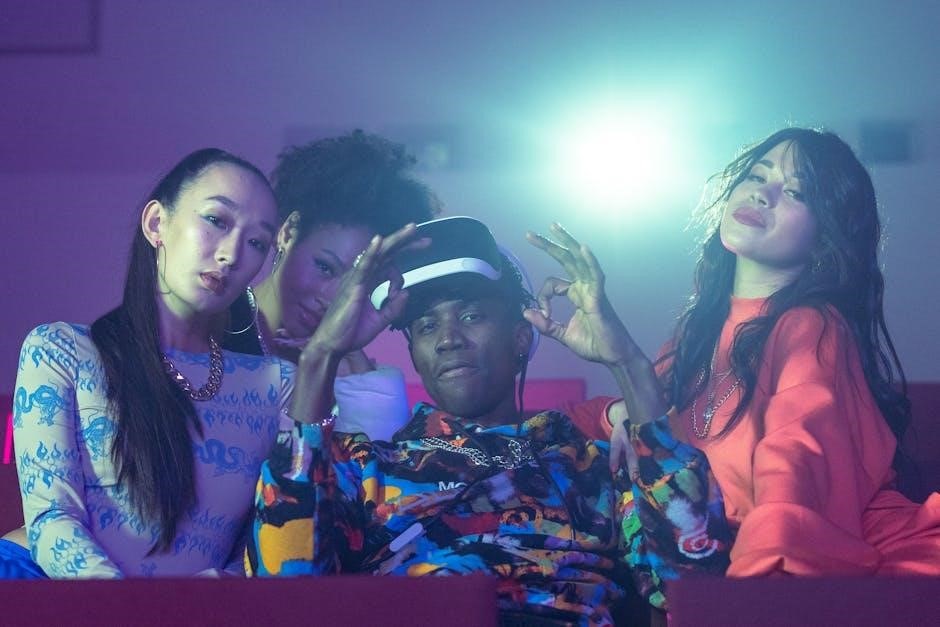The Fight Club movie script, adapted from Chuck Palahniuk’s novel, explores themes of consumer culture, toxic masculinity, and rebellion. Available as a PDF, it reveals the story’s dark, subversive essence, offering insight into its complex characters and shocking narrative twists.
Overview of the Fight Club Movie
Directed by David Fincher, Fight Club (1999) is a psychological thriller starring Edward Norton as an unnamed narrator suffering from insomnia and a sense of purposelessness. He forms a bizarre friendship with Tyler Durden (Brad Pitt), a charismatic soap salesman, leading to the creation of an underground fight club. The story spirals into chaos as the club evolves into a subversive movement called Project Mayhem. Exploring themes of consumerism, toxic masculinity, and rebellion, the film critiques modern society’s emptiness. Its shocking twists and dark humor have made it a cult classic, with the script widely available as a PDF for analysis.
Significance of the Script in Understanding the Film
The Fight Club script is crucial for understanding the film’s layered narrative and thematic depth. It reveals the complexities of the narrator’s unreliable perspective and the symbolic motifs, such as the Paper Street house and the space monkeys. The script’s dialogue, particularly exchanges between the narrator and Tyler, highlights their dual identity and philosophical debates. By examining the screenplay, viewers can uncover subtle clues about the narrator’s breakdown and the true nature of Tyler Durden. This insight enriches the film’s exploration of consumerism, masculinity, and rebellion, making the script an essential resource for analysis and appreciation.

Background of the Fight Club Script
The Fight Club script, adapted from Chuck Palahniuk’s novel, was written by Jim Uhls. Its evolution during production refined themes of rebellion and masculinity, becoming a cult classic.
Adaptation from Chuck Palahniuk’s Novel
The Fight Club script was adapted from Chuck Palahniuk’s 1996 novel of the same name, maintaining its dark, subversive tone and exploration of consumer culture. Screenwriter Jim Uhls worked closely with director David Fincher to ensure the film stayed true to the novel’s themes of toxic masculinity and rebellion. While the script adhered to the book’s core narrative, it also expanded on certain characters, like Tyler Durden, to enhance the story’s cinematic impact. The adaptation seamlessly translated Palahniuk’s provocative ideas into a visually striking film, earning widespread acclaim. The script is now available as a PDF for analysis and study.
The Role of Screenwriter Jim Uhls
Jim Uhls, the screenwriter behind Fight Club, played a pivotal role in translating Chuck Palahniuk’s novel into a cinematic masterpiece. His script captured the essence of the book’s themes, including consumerism and toxic masculinity, while adding layers to characters like Tyler Durden. Uhls’ ability to balance the narrator’s internal conflict with the film’s visual intensity was crucial. His work earned him recognition, and the script, now available as a PDF, remains a study of adapting complex literature into film. Uhls’ contribution to Fight Club is a testament to his skill in storytelling and character development.
Evolution of the Script During Production
The Fight Club script underwent significant changes during production, with director David Fincher and screenwriter Jim Uhls refining key scenes. For instance, the iconic “You’re thinking of vampires” line was tweaked for clarity. The script’s evolution included toning down certain violent scenes while amplifying the narrator’s internal struggle. The ending, initially more ambiguous, was revised to enhance its shocking impact. These adjustments ensured the film’s themes of rebellion and identity were underscored effectively. The final script, available as a PDF, reflects these collaborative refinements, making it a compelling study of cinematic storytelling.

Themes and Analysis
The Fight Club script delves into consumer culture, masculinity, and rebellion, offering a raw critique of societal norms. Its PDF version provides a deeper dive into the film’s themes.
Exploration of Consumer Culture
The Fight Club script vividly portrays a society consumed by materialism, where characters feel empty despite their wealth. The narrator, an insomniac suffering from consumerist alienation, finds no fulfillment in his corporate job or IKEA furniture. His identity crisis mirrors a broader societal issue, where people define themselves through possessions rather than meaningful connections. The film critiques the commodification of life, as characters like Tyler Durden reject societal expectations, embracing chaos over conformity. This theme is central to the script, highlighting the destructive nature of consumer culture and the longing for authenticity in a hyper-materialistic world.
Themes of Masculinity and Violence
The Fight Club script delves into toxic masculinity, using the titular club as a space for men to express aggression and reclaim their lost sense of identity. Tyler Durden embodies this theme, advocating for violence as a form of liberation from societal expectations. The script portrays violence not only as catharsis but also as a means of rebellion against modern life’s emasculation. This duality reflects the tension between traditional masculine ideals and contemporary culture. The exploration of these themes highlights the destructive potential of unchecked aggression, offering a critical lens on societal norms and the male psyche.
The Concept of the Unreliable Narrator
The Fight Club script masterfully employs the unreliable narrator trope, with the protagonist’s fractured psyche obscuring truth. His identity remains ambiguous, and his perception of events is deeply skewed. The narrator’s mental instability and eventual revelation that he and Tyler Durden are the same person challenge the audience’s understanding of reality. This narrative technique forces viewers to question the validity of everything they witness, adding layers of complexity to the story. The unreliable narrator underscores themes of identity fragmentation and the blurred lines between reality and delusion, making the film a thought-provoking exploration of mental health and perception.
Plot Structure
The Fight Club script follows the narrator’s descent into madness, forming the club with Tyler Durden, escalating into chaos with Project Mayhem, and culminating in a shocking revelation.
The Narrator’s Journey and Breakdown
The narrator’s journey in Fight Club begins with insomnia and a sense of purposelessness, escalating into a mental breakdown. His identity crisis deepens as he forms a fight club with Tyler Durden, symbolizing his rebellion against societal expectations. The script vividly portrays his descent into madness, blurring reality and fantasy. This transformation mirrors the audience’s own frustrations with consumer culture, making his breakdown both tragic and relatable. The narrator’s struggle culminates in a shocking revelation, leaving a lasting impact on viewers.
Formation of the Fight Club
The fight club originates as a cathartic outlet for the narrator and Tyler Durden, evolving from clandestine meetings into a subversive movement. Initially, the club serves as a space for men to escape societal expectations, embracing raw aggression. Tyler’s charisma and the narrator’s vulnerability create a volatile dynamic. The club’s rules, such as “you do not talk about fight club,” emphasize secrecy and exclusivity. This underground phenomenon spreads rapidly, reflecting a broader rebellion against consumer culture and modern alienation. The fight club becomes a symbol of resistance, transforming its participants and setting the stage for chaos.
Rise of Project Mayhem
Project Mayhem emerges as the narrator and Tyler Durden expand their influence beyond underground fights. The movement evolves into a coordinated, anarchic force, recruiting disillusioned men as “space monkeys.” Tyler’s leadership solidifies the group’s purpose: to dismantle societal norms and consumer culture. The project escalates into acts of vandalism and sabotage, symbolizing a rebellion against modern alienation. The narrator’s grip on reality falters as Tyler’s control intensifies, blurring the line between chaos and revolution. Project Mayhem becomes a catalyst for destruction, reflecting the film’s exploration of masculinity, rebellion, and the collapse of societal structures. Its rise signifies the characters’ descent into anarchy.
Climax and Resolution
The climax unfolds as the narrator confronts Tyler, realizing they are the same person. A dramatic showdown occurs, with the narrator shooting himself to eliminate Tyler. Project Mayhem’s explosives are detonated, destroying credit card companies. The resolution shows the narrator and Marla holding hands, suggesting a fragile hope amidst chaos. The film’s ending leaves ambiguity, hinting at the narrator’s potential recovery and the lasting impact of Project Mayhem. This conclusion ties together themes of identity, rebellion, and redemption, providing a haunting yet thought-provoking finish to the story. The resolution underscores the film’s critique of modern society.

Character Development
The narrator’s identity crisis, Tyler Durden’s enigmatic presence, and Marla’s catalyst role drive the script’s exploration of flawed, evolving characters, revealing their complexities and transformations.
The Narrator’s Identity Crisis
The unnamed narrator, a white-collar worker, struggles with insomnia and a sense of purposelessness in a consumer-driven world. His identity crisis deepens as he becomes increasingly disconnected from society, leading to the creation of Tyler Durden as his alter ego. The script masterfully portrays his emotional breakdown and transformation, exploring themes of masculinity, rebellion, and the fragmentation of self. Through his journey, the narrator’s inability to cope with modern life’s emptiness is laid bare, culminating in a shocking revelation that reshapes his understanding of reality and identity. This arc is central to the film’s exploration of psychological turmoil.
Tyler Durden: The Enigmatic Figure

Tyler Durden emerges as the narrator’s charismatic yet volatile alter ego, embodying rebellion and chaos. His enigmatic presence captivates the narrator and others, symbolizing a rejection of societal norms. With his sharp wit and fearless attitude, Tyler becomes the driving force behind the fight clubs and Project Mayhem. His charm and unpredictability make him a compelling figure, while his true nature remains obscured. Through Tyler, the script explores themes of identity, rebellion, and the allure of destruction, blurring the lines between reality and fantasy. His character serves as both a catalyst for change and a reflection of the narrator’s inner turmoil.
Marla Singer: The Catalyst for Change
Marla Singer, portrayed as a mysterious and emotionally detached figure, becomes a pivotal catalyst in the narrator’s journey. Her self-destructive tendencies and dark humor draw the narrator into a twisted relationship, mirroring his own inner chaos. Marla’s presence disrupts the narrator’s mundane life, pushing him closer to Tyler Durden and the fight clubs. Despite her enigmatic nature, she embodies the same existential despair that fuels the narrator’s rebellion. Her role in the story highlights the interconnectedness of their struggles, serving as a reflection of the narrator’s own emotional turmoil and the broader societal critique woven into the script.
Supporting Characters and Their Roles
The supporting characters in Fight Club play crucial roles in shaping the narrator’s descent into chaos. The narrator’s boss embodies corporate monotony, pushing him toward rebellion. Marla Singer, though central, acts as a mirror to his despair. The police commissioner represents societal control, contrasting with the anarchy of fight clubs. These characters, along with others like the mysterious figures in Project Mayhem, collectively highlight the narrator’s internal struggle and the broader critique of modern society. Their interactions weave a complex tapestry, driving the story’s exploration of identity, rebellion, and existential crisis. Each character serves as a catalyst, propelling the narrator deeper into the abyss.

Symbolism and Motifs
The Paper Street house symbolizes rebellion, while the gun represents power and control. Space monkeys embody chaotic societal collapse. These motifs reflect the film’s exploration of toxic masculinity and consumer culture.
The Paper Street House
The Paper Street House in the Fight Club script symbolizes rebellion and decay, serving as the birthplace of Fight Club and Project Mayhem. Its dilapidated state mirrors the narrator’s internal chaos and rejection of consumer culture. The house becomes a sanctuary for the fight club, where men escape societal expectations. It also represents Tyler Durden’s influence, transforming from a neglected space into a hub for anti-establishment activities. The Paper Street House embodies the film’s themes of destruction and liberation, highlighting the characters’ desire to break free from modern society’s constraints.
The Gun as a Symbol of Power
The gun in the Fight Club script is a potent symbol of power and control, often used to enforce loyalty and dominance within Project Mayhem. It represents the shift from the narrator’s passive existence to Tyler Durden’s assertive worldview; In key scenes, the gun is a tool for transformation, such as when Tyler places it in the narrator’s mouth, symbolizing his takeover. The weapon also embodies the threat of violence that underpins the group’s activities, reinforcing Tyler’s authority and the anarchic ideology of the fight club. Its presence underscores the themes of masculinity and rebellion central to the story.
The Concept of Space Monkeys
The Space Monkeys in the Fight Club script symbolize the chaotic, obedient followers of Tyler Durden’s anarchic ideology. These individuals, often recruited from the fight clubs, embody the destruction of societal norms. They are nameless, faceless drones who carry out Project Mayhem’s sabotage, reflecting the film’s critique of consumer culture and conformity. The Space Monkeys’ actions, such as burning credit records, highlight their role in dismantling societal structures. Their existence underscores the themes of rebellion and the breakdown of individual identity, serving as a testament to Tyler’s influence and the narrator’s descent into madness.

Production and Reception
The Fight Club script was brought to life by director David Fincher, facing challenges like low budgets and controversial themes. Initially divisive, the film gained cult status, praised for its bold narrative and social commentary, leaving a lasting impact on pop culture.
Challenges in Filming the Script
Filming Fight Club faced significant challenges, including a tight budget and controversial themes. Director David Fincher navigated these issues, emphasizing the script’s dark humor and subversive tone. The film’s exploration of toxic masculinity and rebellion required careful balance to avoid glorifying violence. Despite initial skepticism from executives, Fincher’s vision prevailed, transforming the script into a visually striking and thought-provoking film. These challenges ultimately contributed to the movie’s cult status and enduring influence on modern cinema.
Critical Reception and Cultural Impact
Fight Club initially polarized critics but has since become a cult classic. Its raw portrayal of consumerism and masculinity resonated deeply, sparking debates and cementing its influence on popular culture. The film’s script, adapted by Jim Uhls, was praised for its bold narrative and complexity. Despite early controversy, Fight Club is now celebrated as a groundbreaking commentary on modern societal issues, leaving a lasting legacy in cinema and inspiring countless adaptations and references in media.

Downloading the Fight Club Script
The Fight Club script is widely available as a PDF online. Fans can legally access it through platforms like IMSDb or by downloading it from trusted sources.
Availability of the PDF Version
The Fight Club script is widely accessible in PDF format, available for free download on platforms like IMSDb and other trusted sources. The 123-page document includes the full screenplay, capturing the film’s dark themes, complex characters, and iconic dialogue. Fans and filmmakers often study this script for its masterful storytelling and subversive commentary. Legal access ensures a seamless way to explore the narrative’s depth, making it a valuable resource for both enthusiasts and scholars interested in the film’s structure and artistic vision.
How to Access the Full Script Legally
To access the Fight Club script legally, visit reputable websites like IMSDb or Scripts.com, which offer free PDF downloads. Ensure you use trusted sources to avoid unauthorized content. Additionally, platforms like Amazon or Google Books may provide paid options for high-quality versions. Always verify the source’s legitimacy to support copyright laws and enjoy the script responsibly. This ensures a seamless and lawful way to explore the iconic screenplay.

Cultural Impact
Fight Club’s script has profoundly influenced modern film and media, sparking conversations on consumerism and masculinity. Its cult status endures, shaping cultural narratives and inspiring new works.
Fight Club as a Cult Classic
Fight Club has become a cult phenomenon, resonating with audiences for its bold critique of modern society and exploration of masculinity. The film’s dark humor, subversive themes, and iconic performances by Edward Norton and Brad Pitt have cemented its status as a timeless classic. Its script, now widely available as a PDF, continues to inspire new generations of filmmakers and viewers, solidifying its legacy as a groundbreaking work in cinematic history. The film’s influence extends beyond the screen, with its quotable lines and memorable scenes becoming ingrained in popular culture.
Influence on Popular Culture
Fight Club’s influence on popular culture is profound, with its iconic dialogue and themes of rebellion becoming deeply ingrained in society. The film’s critique of consumerism and toxic masculinity has inspired countless works in film, literature, and music. Its visual style and direction have set trends, and its memorable characters, like Tyler Durden, have become cultural symbols. The movie’s exploration of identity and societal norms continues to resonate, making it a frequent subject in academic and cultural discussions. Fight Club’s legacy is evident in its enduring presence in media and its impact on modern storytelling, ensuring its influence for generations to come.
The Fight Club script, available as a PDF, remains a cultural phenomenon, offering profound insights into themes of consumerism, masculinity, and rebellion. Its enduring influence and iconic storytelling ensure its legacy as a modern classic.

Final Thoughts on the Fight Club Script
The Fight Club script is a masterful adaptation of Palahniuk’s novel, capturing its raw intensity and subversive themes. Its exploration of consumer culture and toxic masculinity resonates deeply, while its non-linear narrative and unreliable narrator add layers of complexity. The script’s evolution during production, including significant changes to tone and structure, underscores its dynamic nature. As a PDF, it provides a unique window into the film’s creation, offering insights for writers and cinephiles alike. Its enduring influence on popular culture solidifies its place as a modern cinematic classic.
Legacy of the Film and Its Script
Fight Club’s script and the film it inspired have left an indelible mark on cinema and culture. Its exploration of masculinity, consumerism, and rebellion continues to resonate, influencing countless works in film and literature. The script’s availability as a PDF has made it a valuable resource for writers and filmmakers, showcasing its meticulous craftsmanship. The film’s cult status and enduring popularity highlight its timeless relevance, cementing its legacy as a bold critique of modern society and a testament to innovative storytelling.
